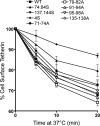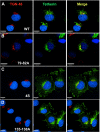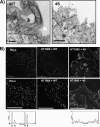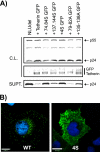The tetherin/BST-2 coiled-coil ectodomain mediates plasma membrane microdomain localization and restriction of particle release
- PMID: 22130541
- PMCID: PMC3302402
- DOI: 10.1128/JVI.05906-11
The tetherin/BST-2 coiled-coil ectodomain mediates plasma membrane microdomain localization and restriction of particle release
Abstract
Tetherin/BST-2 forms a proteinaceous tether that restricts the release of a number of enveloped viruses following viral budding. Tetherin is an unusual membrane glycoprotein with two membrane anchors and an extended coiled-coil ectodomain. The ectodomain itself forms an imperfect coil that may undergo conformational shifts to accommodate membrane dynamics during the budding process. The coiled-coil ectodomain is required for restriction, but precisely how it contributes to the restriction of particle release remains under investigation. In this study, mutagenesis of the ectodomain was used to further define the role of the coiled-coil ectodomain in restriction. Scanning mutagenesis throughout much of the ectodomain failed to disrupt the ability of tetherin to restrict HIV particle release, indicating a high degree of plasticity. Targeted N- and C-terminal substitutions disrupting the coiled coil led to both a loss of restriction and an alteration of subcellular distribution. Two ectodomain mutants deficient in restriction were endocytosed inefficiently, and the levels of these mutants on the cell surface were significantly enhanced. An ectodomain mutant with four targeted serine substitutions (4S) failed to cluster in membrane microdomains, was deficient in restriction of particle release, and exhibited an increase in lateral mobility on the membrane. These results suggest that the tetherin ectodomain contributes to microdomain localization and to constrained lateral mobility. We propose that focal clustering of tetherin via ectodomain interactions plays a role in restriction of particle release.
Figures









Similar articles
-
The size and conservation of a coiled-coil structure in the ectodomain of human BST-2/tetherin is dispensable for inhibition of HIV-1 virion release.J Biol Chem. 2012 Dec 28;287(53):44278-88. doi: 10.1074/jbc.M112.418822. Epub 2012 Nov 14. J Biol Chem. 2012. PMID: 23152502 Free PMC article.
-
Structural basis of HIV-1 tethering to membranes by the BST-2/tetherin ectodomain.Cell Host Microbe. 2010 Apr 22;7(4):314-323. doi: 10.1016/j.chom.2010.03.005. Cell Host Microbe. 2010. PMID: 20399176 Free PMC article.
-
Structural and biophysical analysis of BST-2/tetherin ectodomains reveals an evolutionary conserved design to inhibit virus release.J Biol Chem. 2011 Jan 28;286(4):2987-97. doi: 10.1074/jbc.M110.190538. Epub 2010 Nov 17. J Biol Chem. 2011. PMID: 21084286 Free PMC article.
-
Antiviral inhibition of enveloped virus release by tetherin/BST-2: action and counteraction.Viruses. 2011 May;3(5):520-40. doi: 10.3390/v3050520. Epub 2011 May 6. Viruses. 2011. PMID: 21994744 Free PMC article. Review.
-
Transmembrane interactions of HIV-1 Vpu and tetherin.Curr HIV Res. 2012 Jun;10(4):292-7. doi: 10.2174/157016212800792450. Curr HIV Res. 2012. PMID: 22524177 Review.
Cited by
-
Resilience of BST-2/Tetherin structure to single amino acid substitutions.PeerJ. 2019 May 31;7:e7043. doi: 10.7717/peerj.7043. eCollection 2019. PeerJ. 2019. PMID: 31183261 Free PMC article.
-
Bone Marrow Stromal Antigen 2 Is a Novel Plasma Biomarker and Prognosticator for Colorectal Carcinoma: A Secretome-Based Verification Study.Dis Markers. 2015;2015:874054. doi: 10.1155/2015/874054. Epub 2015 Oct 1. Dis Markers. 2015. PMID: 26494939 Free PMC article.
-
Baculovirus FP25K Localization: Role of the Coiled-Coil Domain.J Virol. 2016 Oct 14;90(21):9582-9597. doi: 10.1128/JVI.01241-16. Print 2016 Nov 1. J Virol. 2016. PMID: 27512078 Free PMC article.
-
Restriction of Retroviral Replication by Tetherin/BST-2.Mol Biol Int. 2012;2012:424768. doi: 10.1155/2012/424768. Epub 2012 Jul 2. Mol Biol Int. 2012. PMID: 22811908 Free PMC article.
-
HIV-1 Env- and Vpu-Specific Antibody-Dependent Cellular Cytotoxicity Responses Associated with Elite Control of HIV.J Virol. 2017 Aug 24;91(18):e00700-17. doi: 10.1128/JVI.00700-17. Print 2017 Sep 15. J Virol. 2017. PMID: 28701393 Free PMC article.
References
Publication types
MeSH terms
Substances
Grants and funding
LinkOut - more resources
Full Text Sources
Medical
Research Materials

